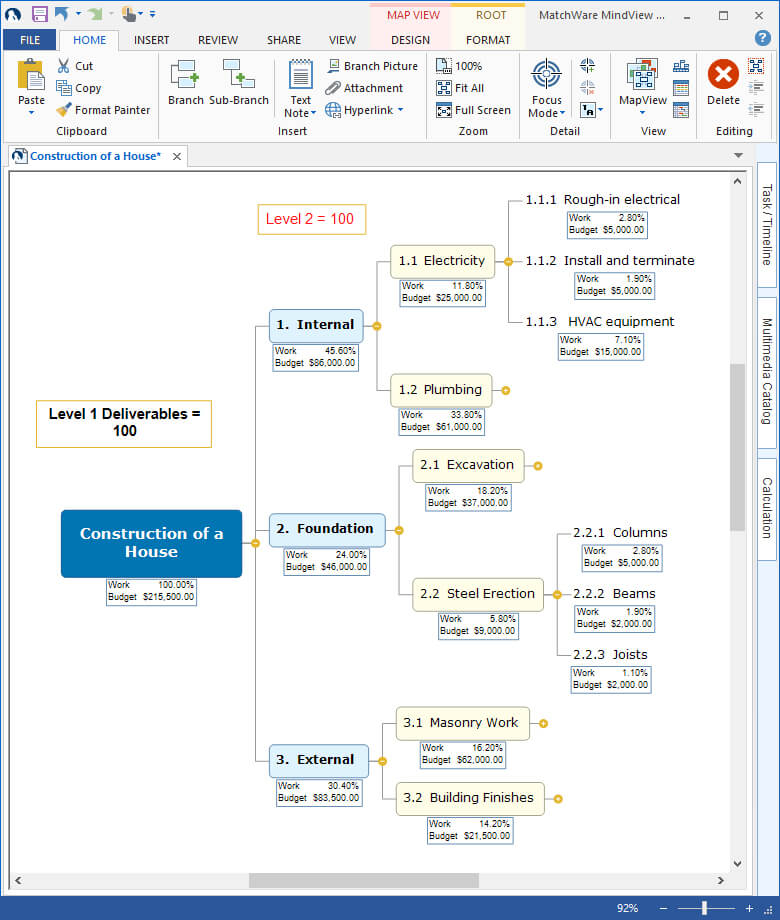Wbs In Ms Project Example
MS Project 2013 - Work Breakdown Structure (WBS) - MS Project 2013 Work Breakdown Structure (WBS) - MS Project 2013 Online Training - MS Project 2013 online video training for beginners to teach basic to advanced concepts with examples including covering Overview, Task creation, Predecessors, General Options, Work Breakdown Structure, Naming Convention, Creation of Calendar, Assigning of. WORK BREAKDOWN STRUTURE (WBS) TEMPLATE Introduction. The Work Breakdown Structure (WBS) is a view into the project which shows what work the project encompasses. It is a tool which helps to easily communicate the work and processes involved to execute the project.
Download Excel WBS. This is a FREE Work Breakdown Structure (WBS) template in Excel and PDF. It documents the project WBS in table format.The template is fully editable with Excel and can be converted or changed to suit specific project requirements. An explanation of the contents of the template is shown below and hints and tips are includes in the template.
Field

WBS template
Excel download - WBS TEMPLATE (excel)
PDF download - WBS TEMPLATE (PDF)
Project Templates to download
- WBS Checklist - Download a Free checklist for reviewing Work Breakdown Structures
- Excel Project Plan template - Download a free Excel planning template with Gantt chart.
- WBS examples - 22 Examples of real world Work Breakdown Structures
In this article, we will discuss how to apply the traditional Work Breakdown Structure (WBS) codes that still supported in Microsoft Project 2013
A WBS (Work Breakdown Structure) is a decomposition of a project into parts. It is usually hierarchical in nature. WBS codes provide a means of numbering the tasks in a project according to such a hierarchy.
They are often used according to standards developed by national and international bodies. It can provide a valuable link to other management and administrative elements of projects, such as finance and procurement.
Microsoft Studios brings you three epic Age of Empires III games in one monumental collection for the first time. Download the zip file and then simply extract the contents (Christmas.xml and Christmas.xs) to your: My DocumentsMy GamesAge of Empires 3RM folder. Immerse yourself in the award-winning strategy experience. Microsoft Studios brings you three epic Age of Empires III games in one monumental collection for. Age of mythology 3 download. Mar 12, 2019 - The age of mythology means an ancient time when people believed in different Gods, each of them with different strengths. While the majority. Oct 26, 2005 - Age of Empires III is an historically-based real-time strategy game designed by Ensemble Studios, makers of Age of Mythology and Halo Wars.
In early versions of MS Project, the use of WBS codes was a major feature. Partly, because many users of project management software were using the codes.
In more recent times, project management software is being used by a much wider range of people and WBS codes are generally used less. But for those who do use them, they are still an essential feature of Project 2013.

Let’s take an existing project and create WBS codes for the tasks in it.
Open the project, and select the Project tab. In the Properties group click WBS.
Select the option Define Code….
The WBS Code Definition dialog is used to define the WBS codes that we need.
At the top of the dialog, there is a preview field that shows how the codes will look. This is built up as you make selections in the dialog.
Next, there is the first user-enterable field where you enter a prefix for the codes. In this project, we’re building a house. Let’s suppose that we are building 6 houses code A-F. This is the plan for House B. So, we’ll use a prefix of B for the WBS codes in this project.
Now, you can define as many levels below this as we need. Our lowest (outline) level of task if 3, so just define codes to the 3rd level. At each level, you can choose from the available Sequence options.

You can specify a length for that part of the code and can select a separator. Note that you could also choose to have no separator at all.
As you make these choices the resulting WBS code is previewed at the top of the dialog.
Note the two important options near the bottom of the dialog. One specifies whether you want Project 2013 to generate WBS codes for new tasks.
Wbs In Ms Project Example Files
Checking the other causes Project 2013 to verify the uniqueness of newly (manually) entered WBS codes.
Click OK.
To see the WBS codes you need to show the WBS column in the table. Having done that, this is what some of the codes look like.
One very important aspect of WBS codes is that although they can be automatically created, they are not automatically modified when you change the schedule.
Wbs In Ms Project Examples
You might expect them to be renumbered if you change the sequence of tasks in a plan or insert new tasks, but they aren’t.
The reason for this is that it is often the case that once a task has a WBS code you definitely do not want that code to change as you may already have used it in references to other entities inside or outside your project.
For example, the code may have been used to procure resources from an external source.
However, you may actually want or need to renumber WBS codes and there is a facility within Project 2013 to do this. Select the Project tab and then click WBS in the Properties group. Select Renumber….
The WBS Renumber dialog lets you renumber the entire project, or you can select some tasks before you invoke it and it will just renumber those.